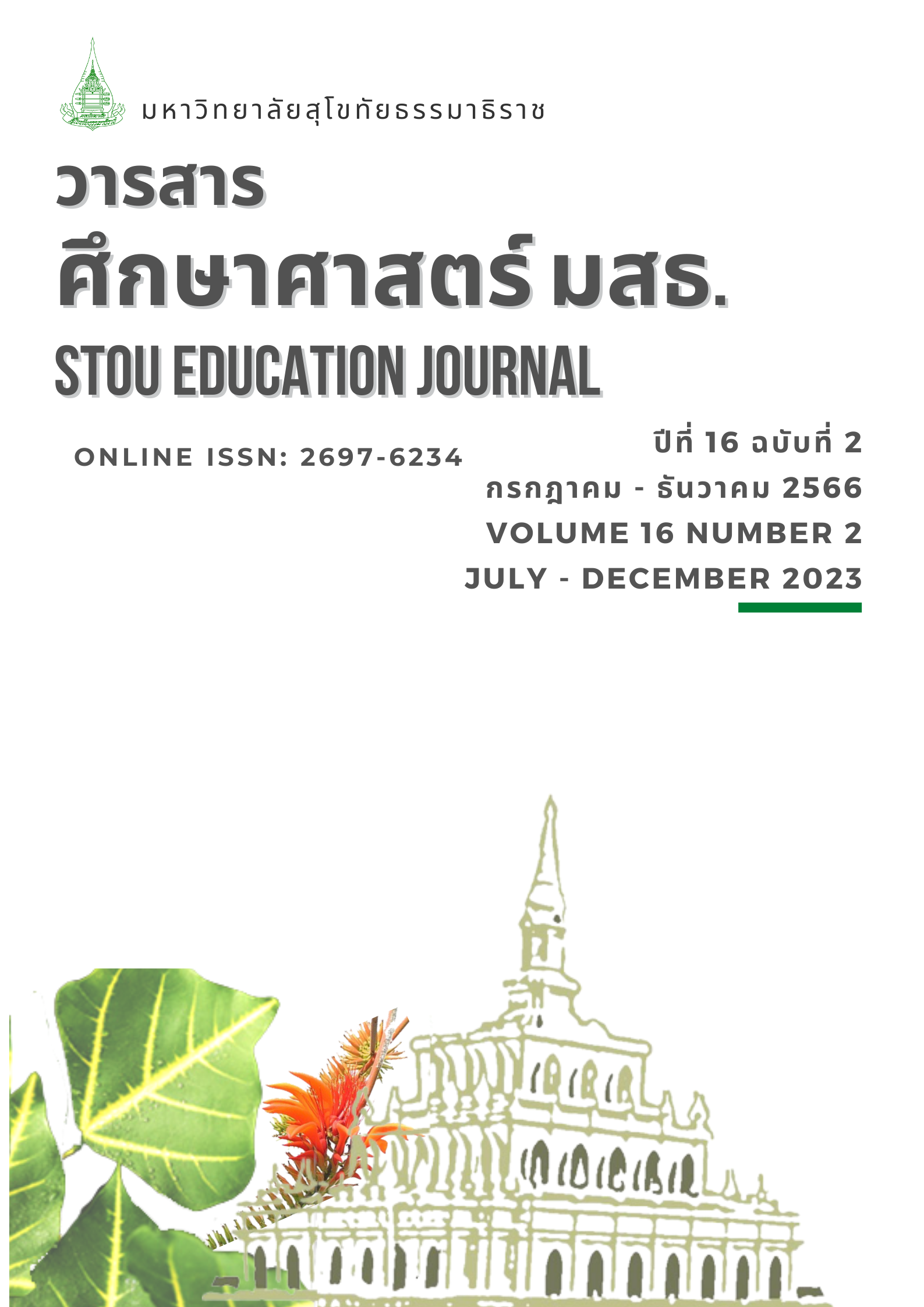An Effect Size Analysis of Whole School Improvement Innovation on Students’ Socio-emotional Attributes
Main Article Content
Abstract
This study aimed to analyze the effect size of Whole School Improvement Innovation on students’ socio-emotional attributes. The research sample consisted of 518 upper primary and lower secondary students obtained by multi-stage random sampling. The employed research instrument was a self-assessment inventory for TSQP students that was adapted from SENNA Inventory 2.0, which measured five socio-emotional attributes: open-mindedness, conscientious self-management, engaging with others, caring for others (amity), and negative emotion regulation. The instrument was a three-level rating scale questionnaire containing 29 items. Data were analyzed using descriptive statistics and effect size analysis. Then, statistical tests, including chi-square test, Cramer’s V, and one-way MANOVA, were performed. Results revealed that students’ mean scores of five socio-emotional attributes were at the medium level. In addition, students in schools under different participating networks that used different learning innovations, had significant differences in four attributes, including open-mindedness, conscientious self-management, engaging with others, and caring for others (amity) at the .05 level, excepting the attribute of negative emotion regulation, which no significant difference was found.
Article Details
References
ชาริณี ตรีวรัญญู. (2560). การสร้างชุมชนแห่งการเรียนรู้เชิงวิชาชีพด้วยการพัฒนาบทเรียนร่วมกัน: แนวคิดและแนวทางสู่ความสำเร็จ. วารสารครุศาสตร์, 45(1), 299-319. https://so02.tci.thaijo.org/index.php/EDUCU/ article/view/106153
ณัฏฐภรณ์ หลาวทอง, สิวะโชติ ศรีสุทธิยากร, และ Fry, G. (2563). โครงการวิจัยการพัฒนาดัชนีวัดความเสมอภาคและความเท่าเทียมทางการศึกษาของประเทศไทย. คณะครุศาสตร์ จุฬาลงกรณ์มหาวิทยาลัย.
นิภาพร กุลสมบูรณ์ และ สุวิมล ว่องวาณิช. (2565). Active learning: จากความเข้าใจที่คลาดเคลื่อนสู่ปรัชญาและทฤษฎีรากฐาน ตั้งทิศให้ถูก เพื่อไม่ทิ้งครูให้หลงทางอีกต่อไป. คุรุสภาวิทยาจารย์, 3(2), 1-17. https://ph02.tci-thaijo.org/index.php/withayajarnjournal/article/view/247309
พิณสุดา สิริธรังศรี, สรรเสริญ สุวรรณ์, สินธะวา คามดิษฐ์, พรเทพ รู้แผน, อรทัย มูลคำ, สุวิทย์ มูลคำ, พงษ์ภิญโญ แม้นโกศล, แอนจิรา ศิริภิรมย์, วิทยา วรพันธุ์, จรัสฤทธิ์ กลิ่นสุวรรณ และ วาสนา วิสฤตาภา. (2565). การดำเนินงานโครงการวิจัยและประเมินผลโครงการโรงเรียนพัฒนาตนเอง ปี 2564. กองทุนเพื่อความเสมอภาคทางการศึกษา.
อริยา คูหา, สรินฎา ปุติ, และ ฮานานมูฮิบบะตุดดีน นอจิ. (2562). โลกที่เปลี่ยนแปลง การเรียนรู้ที่ผ่านสู่
Active learning. วารสารศึกษาศาสตร์ มหาวิทยาลัยสงขลานครินทร์ วิทยาเขตปัตตานี, 30(2), 1-13. https://so02.tci-thaijo.org/index.php/edupsu/article/view/214011
Carpenter, D. (2017). Collaborative inquiry and the shared workspace of professional learning communities. International Journal of Educational Management, 31, 1069-1091. https://dx.doi.org/10.1108/ijem-10-2015-0143
CBE Thailand. (2565). สมรรถนะหลัก 6 ด้าน. https://cbethailand.com/หลักสูตร-2/กรอบหลักสูตร/สมรรถนะหลัก-6-ประการ/
Cohen, J. (2013). Statistical power analysis for the behavioral sciences. Routledge.
Collard, P., Németh, S., Vince, D., & Kaderjak, A. (2016). Creating creative learning environments by Creative Partnerships Programme—Evaluation of the Creative Partnerships Pilot Mathematics Programme in Pecs. Creative Education, 7(5), 741-767. https://doi.org/10.4236/ce.2016.75078
Cronbach, L. J., Schönemann, P., & McKie, D. (1965). Alpha coefficients for Stratified-Parallel Tests. Educational and Psychological Measurement, 25(2), 291–312. https://doi.org/10.1177/001316446502500201
Ferguson, C. J. (2009). An effect size primer: A guide for clinicians and researchers. Professional Psychology: Research and Practice, 40(5), 532–538. https://doi.org/10.1037/a0015808
Hannula, M.S. (2015). Emotions in problem solving. In: S. Cho (Eds.). Selected Regular Lectures from the 12th International Congress on Mathematical Education. Springer, Cham. https://doi.org/10.1007/978-3-319-17187-6_16
Harris, A., & Jones, M. (2010). Professional learning communities and system improvement. Improving Schools, 13, 172-181.
Hattie, J. (2008). Visible learning: A synthesis of over 800 meta-analyses relating to achievement. Routledge.
Inprasitha, M. (2022). Lesson study and open approach development in Thailand: A longitudinal study. International Journal for Lesson & Learning Studies, 11, 1-15. https://doi.org/10.1108/IJLLS-04-2021-0029
Primi, R., Santos, D., John, O. P., & De Fruyt, F. (2021a). SENNA inventory for the assessment of social and emotional skills in public school students in Brazil: Measuring both identity and self-efficacy. Frontiers in Psychology, 12, 716639. https://doi.org/10.3389/fpsyg.2021.716639
_______. (2021b). SENNA: inventory for the assessment of social and emotional skills: Technical manual. https://psyarxiv.com/byvpr/


